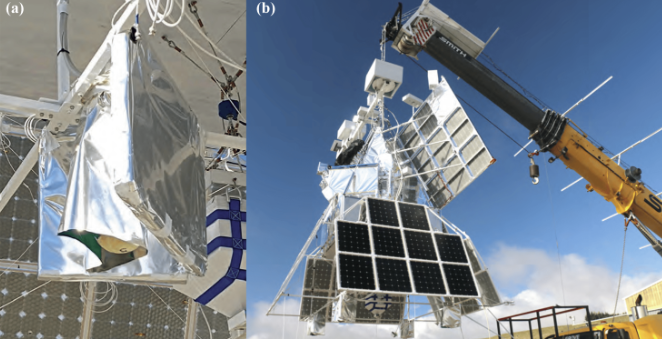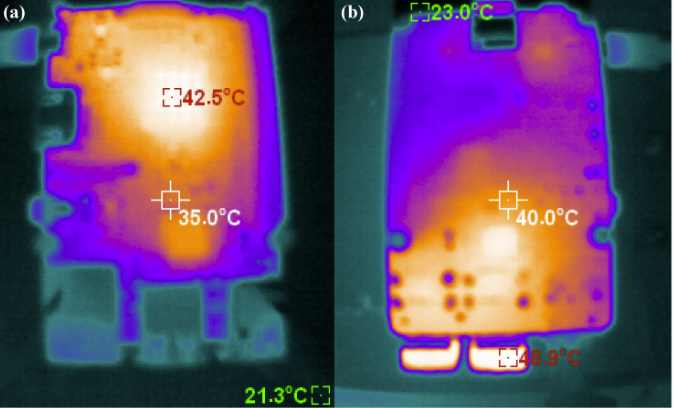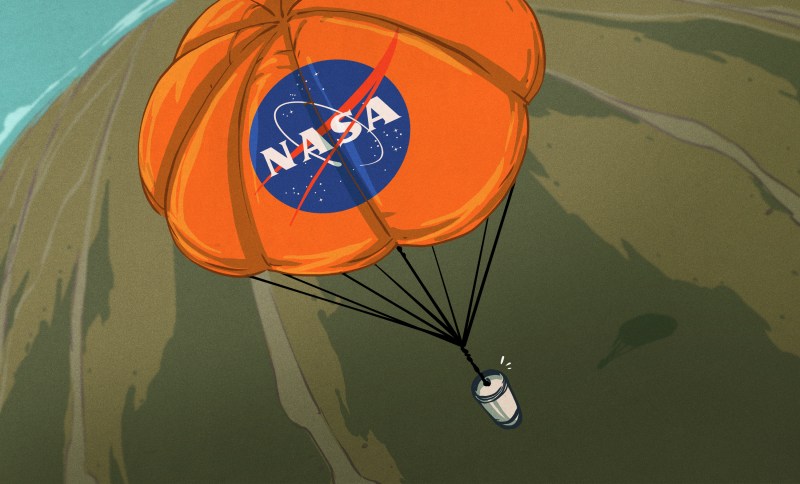Once upon a time, when the earliest spy satellites were developed, there wasn’t an easy way to send high-quality image data over the air. The satellites would capture images on film and dump out cartridges back to earth with parachutes that would be recovered by military planes.
It all sounds so archaic, so Rube Goldberg, so 1957. And yet, it’s still a viable method for recovering big globs of data from high altitude missions today. Really, you ask? Oh, yes indeed—why, NASA’s gotten back into the habit just recently!
Drop It Like It’s 5TB
NASA’s Super Pressure Balloon mission is a very fancy high-altitude balloon that was charged with carrying the Super Pressure Balloon Imaging Telescope, or SuperBIT. Launched from New Zealand, the 18.8-million cubic foot balloon spent almost 40 days aloft in the upper atmosphere to provide a near-space-like environment for the optical equipment. The aim is for the experiment to take measurements regarding weak gravitational lensing of galaxy clusters, as a part of the agency’s hunt for dark matter.
Launched earlier in 2023, the experiment had two main data links—a Starlink connection, and the Tracking and Data Relay Satellite System (TDRSS). Unfortunately, the balloon suffered a failure in its Starlink connection, and an unstable TDRSS link in May this year. Thus, the balloon was instructed to land during a pass over Argentina, while some connection to the balloon was still possible. As the balloon fell back to Earth, the telescope was destroyed as it was dragged along the ground for 3 kilometers when a parachute failed to release upon landing.

Thankfully, all was not lost during the balloon’s unplanned landing, however. That’s all thanks to a payload system designed to return the experiment’s precious data back to Earth separately from the main balloon. The Data Recovery System (DRS) for the craft was designed by Dr Ellen Sirks from the University of Sydney. This nifty recovery package was the topic of a paper published in Aerospace in November.
“This drop package is something we’ve been developing for about five years, but only now have we been able to test it in its final configuration. It’s got to the point where NASA wants to start producing these packages for other science missions as well, so this was really our final test to show that this system works.” said Dr. Sirks.

While high-bandwidth satellite communications are normally the go for offloading data for such a mission, sometimes hurdles occur, or transmissions take too long. “At the moment, the most efficient way for us to download data is to copy it onto an SD drive and just drop it to Earth which is kind of crazy, but it works well,” explains Dr. Sirks. It recalls a famous quote from the earlier days of computing. “Never underestimate the bandwidth of a station wagon full of tapes hurtling down the highway,” from Andrew Tanenbaum in 1981.
Each DRS system contained a parachute and 5 terabytes of solid-state data storage. A global navigation satellite system (GNSS) receiver was also included for positioning data; we more colloquially refer to these as GPS receivers. To enable the DRS systems to report their location during descent and after landing, they carried a short-burst data transceiver that communicated with the Iridium satellite network for reliable uplink almost anywhere on Earth.

Drilling down into the hardware, each DRS module had a Raspberry Pi 3B as the brains of the operation. A 24V DC supply from the balloon’s main payload ran the DRS modules during flight, with two off-the-shelf Energizer lithium 9-volts running the devices during descent. This might sound like an interesting choice of battery for a near-space mission. After all, at a discharge rate of 500 mAh, typical for a Raspberry Pi at moderate load, an Energizer lithium 9V will last maybe 90 minutes at best as per the company’s datasheet. Obviously, double that for a pair of them.
However, the design is smarter than that, because during descent, the DRS uses a low-power microcontroller to run the show, instead of the Raspberry Pi. This provides much longer battery life. These batteries are also a cheap solution that is commercially available almost anywhere on the planet, and under most circumstances, one can assume the DRS will stay put after falling. Plus, space and near-space missions have to consider the risk of polluting the environment and such; a known quantity like an Energizer battery is preferable in that case.
Four SD card readers are plugged into the Pi, two on extension cords, which are charged with storing experiment data. The extension cords were a mitigation for failures on earlier tests where excessive heating took place at the USB ports during heavy writes to the SD cards. A pincer mechanism run by a simple servo is used to release the DRS. The pincer holds a nylon loop on the balloon’s main payload, and when the servo is activated, it releases, dropping away. Another servo pincer mechanism releases the parachute. An Ethernet link is used to attach the DRS to the balloon’s main payload. It’s hooked up with zero extraction force connectors on the main payload, such that the cable pulls free when the DRS is dropped. The whole kit is enclosed in a 3D-printed casing with a foam shell for impact protection and weatherproofing.
The DRS descend in an uncontrolled manner, but by choosing the position and timing of release, it’s possible to roughly predict where the device might land. Sirks’ paper notes that unpopulated areas near roads are ideal for safety and easy recovery.

The balloon actually carried four DRS systems, but only two were dropped during the SuperBIT mission. The other two were left with the payload. This meant that either recovering the payload or the two DRS modules would allow for independent redundant sets of data to be recovered.
There were some minor issues with the devices not initially reporting their locations, thought to be due to the DRS batteries being excessively cold from being up in the stratosphere, and thus delivering lower voltage. However, both devices eventually reported locations after landing and were recovered successfully.
The full paper is well worth the read if you’re eager to engineer your own rugged devices for similar tasks. It’s always impressive to learn about the detailed engineering that goes into any NASA or NASA-adjacent project, and you can often pick up a few tips or tricks for your own projects. So whether you’re ballooning or even building your own spy satellites (really?), take heed of the great lessons from this successful data recovery project!
















A long range drone intercept capture would be really cool
Or perhaps let it be it’s own drone?
Either a steerable parachute or glider platform that brings the SD cards to you.
These things used to be captured mid flight, the Corona series of spy satellites for example, so it makes me wonder if the same process could be used to snag those ‘Chinese spy balloons’.
No, that usually happens to “spy” balloons:
https://hackaday.com/2023/02/18/the-usaf-almost-declares-war-on-illinois-radio-amateurs/
Nope, ‘spy balloons’ (and amateur HAM balloons) fly at around 18,000m (60,000ft), which is above the altitude most aircraft can reach.
The buckets of film from Corona satellites was snagged at more like 5,000m.
In fact, scientific balloons are way beyond that, typically ~33 km (100 kft+). In the neighborhood of 1-10 Torr outside air pressure.
Is that how Dropbox storage works above the clouds?
Explains the occasional access issues: shifts in the jet stream
Never underestimate the bandwidth of a parachute load of SD cards…
Yup. Extreme Sneakernet.
Also have a look at Yohan’s project, R2Home: https://hackaday.com/2022/08/01/r2home-is-ready-to-bring-back-your-high-altitude-payload
Discharge *rate* of 500 mAh?